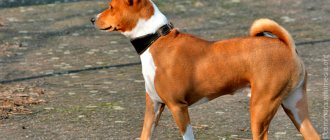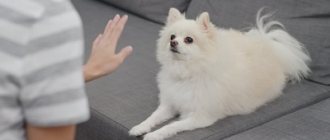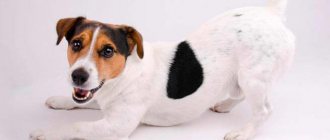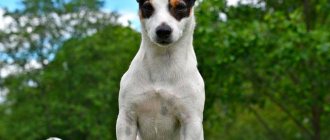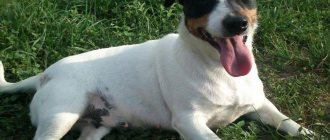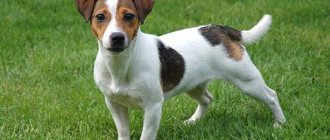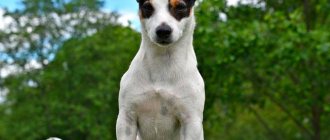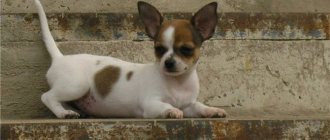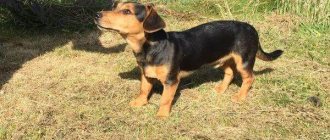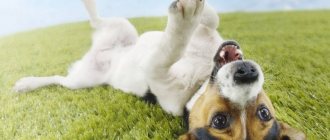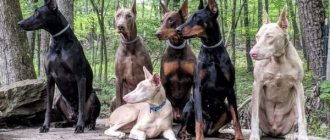Two-color
Bicolor is the color of a Beagle, consisting of two colors - white (closer to cream) and a shade of red. The pigment responsible for redness manifests itself in different intensities:
- red;
- ginger;
- citric.
The division of tones is conditional; there are transitional variations between them. The standard allows all shades from red to light lemon. It is bicolor that is most popular in the UK.
Red is considered the rarest. Its saturation is often compared to brick, but the color is called “mahogany” in another way. The remaining shades between red and lemon are variations of the red tone. Very often the light red color is mistaken for the lemon Beagle color.
Bicolor puppies are most often born completely white and darken closer to the age of one year. However, there is still a way to determine the exact color color: the darker the nose, the lighter the coat. The lemon white Beagle has nose pigment closer to black. Red and white dogs have a more light brown nose.
Sometimes the color of the nose can also change color (from light to dark). This can happen in bitches, in whom the phenomenon depends on the hormonal cycle.
White - red
It is the white and red one that is most often found among bicolor Beagles. It exists in a wide variety of variations: from dark, rich tones to almost pale cream shades.
Interpretations of the red bicolor are very often subject to doubt and controversy. It is easy to confuse it with the unique lemon color or classify the bright shade as a rare red and white. Only experienced beagle breeders are able to independently determine the color of a dog.
It is incorrect to consider the dominant color of the Beagle to be pure white. It is slightly darker than snow white and closer to a light cream or creamy shade. The combination of light cream color and white is called lemon.
Citric
Lemon color is considered the unique color of the breed. It is very difficult to identify, especially for a novice breeder. Lemon color is achieved by maximizing the lightening of the gene responsible for dark colors. Puppies with this color have a dark (almost black) nose from birth.
Lemon shade is a pale cream color that is only slightly darker than base white. A more saturated tone already belongs to red-and-white, although many mistakenly classify it as “lemon”. The principle of determination is simple - the lighter the red pigment, the closer it is to lemon.
Speckled or speckled
Specks are one of the options for displaying tricolor and bicolor. It is characterized by the presence of small black or red spots on the entire body (or in certain areas), as in the photo. The spots can form in large numbers (dense) or at a great distance from each other (sparse). Speckled is not a spotted variety and has nothing in common with the blue merle (merle) color.
Discoloration is genetically determined. You can recognize it in newborn puppies: their paw pads are never pink. The real mark appears already by 4-5 days from birth. Sometimes puppies acquire it at 6-8 weeks.
Motley
The variegated color occupies an ambiguous position. Essentially, it is a combination of two colors, but in different shades. Officially, variegated varieties are recognized only in the UK and the FCI. In total, they identified 3 varieties:
- badger motley (the rarest and most intense, black color predominates);
- hare motley (dominance of red color);
- lemon variegated (lightest).
Most pieds are recorded in the UK, but this does not mean that they are only found in one country. This variety is not rare and sometimes you need to look closely to see the variegated color in the muted tricolor.
Beagle breeders have never come to a consensus on which color combination to accept as a variegated color. Some argue that the presence of “agouti” is sufficient (zonal coloring - the tip of the hair is black, the rest is brown). Others believe that it is necessary to “mix” the brown and black hairs on the Beagle’s body.
With a variegated color, there is no pure snow-white color. It is more reminiscent of creamy or creamy (as is the case with standard bicolor). The color smoothly flows into another shade, which is similar to the usual classic tricolor.
Feeding
There are no special feeding requirements for Russells. Like other dogs, they can be fed natural food or dry granulated concentrated food. Considering the small size of dogs of this breed, they do not need much food. Due to the fact that it is concentrated, its amount per serving is less than the volume of natural food.
In addition, ready-made industrial food is convenient because it significantly saves time on feeding your pet and contains all the necessary vitamins and microelements. However, it is fully balanced only in premium varieties and the holistic type. In cheap analogues, the main ingredient is not meat, but meat flour, which is obtained, at best, from offal, and at worst, from chopped hooves.
Considering that low-quality food can lie on store shelves for a long time, the buyer also runs the risk of purchasing a stale product. If you decide to feed your dog natural food, you should immediately exclude pork and lamb from the list of allowed foods. Meat in the diet should be lean. Beef, turkey, veal and chicken are suitable.
In addition, you need to ensure that the animal receives boneless sea fish, buckwheat and rice porridge for food. An active pet also needs vegetables (with the exception of legumes), which can be flavored with vegetable oil. We must not forget about fermented milk products, which in this case include kefir and low-fat cottage cheese. About once a week, your pet should be treated to eggs (chicken and quail are suitable).
In order for the dog to receive everything it needs for growth, development and maintenance of health, when choosing natural food, it is necessary to add special vitamin complexes to it.
It is important to understand the nuance that an animal’s food should be varied.
Health and congenital genetic diseases
In order to preserve the gene pool, breeders do not allow Jack Russell terriers to be crossed with other species. Due to the fact that this is an artificially bred breed, sometimes representatives have health problems associated with the accumulation of recessive genes. The result is the occurrence of hereditary pathologies. Regardless of good health, the animal is predisposed to certain diseases:
- Allergies are often caused by an increase in the body's immune response to various substances. Occurs due to the consumption of certain foods, the administration of medications or vaccines, insect bites, ingestion of plant pollen, etc.
- Luxation (displacement of the lens) - this pathology sometimes manifests itself between the ages of 3 and 8 years. The displacement can be observed in one or both eyes, it can be anterior or posterior. Moderate luxation is only possible as a result of eye injury.
- Cataracts are hereditary, but there is a risk of their development in older dogs or those with diabetes, exposed to radiation, high temperatures, or after injury.
- Congenital deafness occurs in predominantly white dogs. It is impossible to cure such a hereditary pathology. Here the representative of the breed is helped by a well-developed sense of smell, thanks to which he orients himself in space, even without hearing.
- Displacement of the kneecap - a tendency to this pathology occurs due to a genetic predisposition. The problem can arise and go away on its own, but in some cases it can lead to ligament rupture or arthritis.
- Legg-Calvé-Perthes syndrome (aseptic necrosis of the femoral head) causes lameness and joint pain. Pathology can make itself felt between the ages of 6 months and 1 year. Hip dysplasia is a flattening of the socket of the ligament, in which the head of the femur does not fully fit into the socket and it falls out. The disease is genetic and cannot be treated; only supportive therapy and reduction of the load on the deformed joint are possible.
Cases of Jack Russell Terrier disease with ataxia, myasthenia, and Von Willebrandt disease have been identified - all the result of genetic abnormalities. To avoid the risk of your pet developing serious incurable pathologies, when purchasing a puppy, the health report of the parents is checked. It is recommended to conclude an agreement with the breeder on reimbursement of costs for the treatment of hereditary diseases in the dog sold to him.
How long do Jack Russell terriers live?
The life expectancy of representatives of the breed ranges from 13 to 16 years. Proper care and care are the key to full development and good health. To prevent the occurrence of congenital anomalies, the puppy is periodically examined. To maintain the health of your four-legged friend, they monitor their diet throughout their life. An active pet is given the opportunity to splash out its vigorous energy. If all the conditions for keeping a Jack Russell are met, the animal will live a long and fulfilling life.
Advantages and disadvantages
Advantages:
- Black Jack Russells are small and, due to their compact size, these dogs can live both in a country house and in an apartment.
- They will never refuse to run and play.
- Black Jack Russells are good with children.
- Extraordinarily loyal dogs: they try to accompany their owner everywhere.
- Known for their intelligence and intelligence.
- Caring for this dog is not difficult.
- If the pet is wire-haired or has a transitional coat, then it does not shed.
- The black Jack Russell's coat cleans itself.
Flaws:
- The hyperactivity of such a dog may not please all people.
- Left alone, he gets bored and because of this he may start chewing furniture or peeling off the wallpaper in the room.
- He digs up the soil in the flower beds, and at home he turns over flower pots and tries to make holes in the floor.
- The Black Jack Russell needs proper education and early socialization, without which it can grow up willful, disobedient and aggressive.
- Due to its natural hunting instinct, it can be hostile towards other animals.
- He knows how to cunning and manipulate his owners.
- If your pet is wire-haired or has a transitional coat type, it needs trimming.
Black Jack Russells are strong and resilient: they can do sports such as agility.
Standard dogs and non-standard colors
As for non-standard colors, it should be noted that most of the Pekingese came to us at one time from England. Despite strict culling based on color, experimentation by some breeders, especially among English dog breeders, leads to the appearance of Pekingese of uncharacteristic colors: brown and tan, blue, brown.
These colors have not yet been included in any breed standard. By the way, Pekingese dogs of English selection are distinguished by their larger size and lush coat, in contrast to Chinese standards for miniature Pekingese dogs with soft, silky hair.
The classic, or traditional, color is red. It is quite difficult to predict the appearance of a certain color in a litter, since dogs of this breed are carriers of a wide variety of color genes.
The Pekingese breed is distributed throughout the world. Each country stipulates certain nuances in color. For Czech dog handlers, a white spot on the crown of the head, a dark mask for all coat colors, and symmetry in the location of spots in motley dogs are desirable.
European cynologists allow any color. Breeders in the USA and England do not pay attention to the mask, although they agree that it is a decorative element for Pekingese.
Important! In order to obtain breeders of a rare color, and from them corresponding puppies, it is necessary to work with several generations of Pekingese.
In the 80s, imported manufacturers of colors that were fashionable at that time were brought to Russia: white, orange, light fawn. However, the offspring practically did not adopt these colors, and matings resulted in different genetic forms of color.
How to choose a puppy
To get a pet of a certain color, the owner must pay attention to the puppy's parents. The cub will definitely inherit the appearance of one or two ancestors, so it must be taken into account
For example, if a silver tint to the coat is undesirable, then it is better not to buy a puppy from such a parent. A dog's appearance can change with age. This is how modified colors manifest themselves.
Of course, his appearance is unlikely to affect his love for his pet.
However, it is important to choose the color carefully if the dog is to continue the purebred family.
The puppy's coat color depends on the coat color of the parents.
In order not to make a mistake with the choice, breeders have drawn up several rules to help “predict” the future appearance of the pet:
| Puppy appearance | Forecast for the future |
| The cub has a hard coat structure | An adult dog will have short hair |
| Fur fluffed up like cotton wool | In the future - unclear color lines, dull fur, lack of shine |
| Subtle waves in the hair structure | Over time, a pale silver teak will appear |
| Silky "plumage" | The puppy will have a uniform color and correct fur structure |
What determines coat color?
In mammals, black and yellow pigments are produced, which are contained in granules of hair hairs. They determine the color of the animal’s coat.
Black Pekingese - the color is dominant. But, when crossing black Pekingese with any other colors, it is not a fact that the puppies will be the same black. Black dogs carry genes that cause the development of different colors. A litter may produce puppies that are completely different in color.
The Pekingese has a black and white coat - the color depends on the distribution of coloring pigments in the hairs of the coat. The location of the pigment can be ring-shaped. In this case, the hairs are colored unevenly.
The black color often allows white markings on the paws, forehead and chest. The color has different shades. The hair is characterized by a red color with dark tips of varying lengths.
With a short dark tip, the red color will predominate. If the dark pigment at the end of the hair is longer, the red color will appear darkly rippled, almost black or gray.
The repetition of such rings, i.e., the alternation of yellow and black pigment, forms a zonal coloration. If the black pigment is located at the tip of the hair, and yellow at the base, then the coat will be sable, deer or red with blackening, according to the terminology of French dog handlers.
The ring arrangement of pigments can be of different widths. If distributed evenly, the color will be zoned gray. If the yellow stripes in the ring are wider, then it is reddish-gray.
It is quite difficult to separate colors in puppyhood; the color is defined as gray-fawn or fawn. More often this color is found in combination with a black mask.
The pigment pheomelanin comes in a variety of shades - from yellow to red. The presence of pheomelanin color determines the intensity of the red color common among Pekingese - from light fawn to red-red.
Sable puppies change coat color as they age. If at birth they are dark gray or black, then with age the undercoat becomes lighter, and the growing outer coat turns red.
When babies are immediately born red, only the color intensity changes with age. Red Pekingese can be of any color. When mating with the same red dogs, you can get a wide variety of colors in the litter.
The gray color of the Pekingese varies from light to dark brown, almost black.
Such a variety of shades is found in the guard hair and in the undercoat. This color is also called zone gray among Pekingese.
Dog handlers in Great Britain and the American Kennel Club call this coloring Wild sable, Wolf sable (wild sable or wolf).
White Pekingese are, in fact, very bleached red individuals. The combination of some genes leads to a strong lightening of the red color, even white. This genetic factor is also responsible for the cream color of the Pekingese. The bleached undercoat enhances the impression of white.
The black and tan color is characterized by a constant arrangement of tan marks in strict places: above the eyes, on the cheeks, chest, around the anus, on the inner thighs, on the paws. It is difficult to see the clear outline of the tan contour of the Pekingese due to the long hair and shortened muzzle.
The color of tan marks depends on pheomelanin and ranges from light yellow to dark red.
White spotting can appear in the form of individual white spots. Or it is the main white color of the Pekingese, on which there are spots of a different color. This is caused by depigmentation genes or a break in pigment on the dog’s body. Usually the spots do not merge with each other.
Education and training
If you want to get an obedient and non-aggressive Jack Russell Terrier dog, you need to start training it from the moment it first appears in the house. The puppy must know its place, not only physically, but also in the hierarchy of family members. To accustom a dog to the place where it will sleep in the future, you need to wait until it gets tired of playing and falls asleep, and then carefully move it to the sleeping place. After several such manipulations, the Jack Russell Terrier will get used to its place.
The Jack Russell Terrier is a dominant dog. Despite its miniature size, in its desire to dominate family members, it is not inferior to such large breeds as the English mastiff or sea anemone. They will want to subjugate older people or children to their will, but you cannot follow your pet’s lead, and you must show through your actions that he occupies the lowest place in the hierarchy.
Description of the breed
A notable point that separates the modern Jack Russell Terrier from its other counterparts is its white color with red or black markings. Red markings may vary in shades. Despite the fact that previously the black color was not particularly valued, today these dogs are no less popular among breeders. As for red tones, they can be very dark, almost brown.
Another color option is considered tricolor, in which the main color remains white, and the spots can be black and red. However, whatever the color of the marks, they themselves should be round. In this case, the total area of the spots should not exceed a third of the entire surface of the dog’s coat.
The coat itself can be smooth, with a dense undercoat pressed to the body. This coat should be coarse and thick.
Wool of moderate length does not fit tightly to the body. They are softer to the touch than the previous type of wool.
The brocken option is also allowed, in which the wool can be broken in several places.
This fur coat fits close to the body, does not stick out, and the dog does not have a beard or mustache. However, the type of coat in these dogs is determined no earlier than two months of age. Moreover, even in one litter it can be different, and sometimes even an experienced breeder cannot recognize it.
The exterior allows the height of males to range from 27 to 30 cm, while the height of a female individual should not exceed 25-27 cm. If the dog is tall, it is subject to disqualification. The average weight of an adult dog is 6 kg. It is generally accepted that the weight of a pet should correspond to its height at the rate of 1 kg per 5 cm of height. For example, a dog 25 cm tall should weigh 5 kg.
Representatives of the breed look memorable: the appearance of Russell Terriers was once glorified by the restlessly jumping dog that starred in the film “The Mask” with Jim Carrey. According to the generally accepted standard, a purebred representative of the breed has a flattened skull, moderately wide, tapering from the eye sockets to the jaws. The nose of these animals is painted black, the lips are tight-fitting, black, the jaws are deep and powerful. Dogs have a regular, scissor bite.
The eyes of Russell Terriers are small, although their size is visually increased due to the dark or even black rim around the edges of the eyelids. The eyelids are characterized by complete closure. Ears can be erect or hanging, they are mobile and structural.
The neck of a purebred representative of the breed is strong and strong, the body tends to be rectangular, the croup is fairly even, the loin is small, the sternum is deep, but not wide. The edges of the sternum are defined in front of the shoulders.
The Russell Terrier's paws are powerful and strong, their pads are soft and round, and their gait itself is springy. The tail rises to a vertical position during movement. When the dog is calm, he can hang. The standard allows tail docking, although today this practice is often suppressed by the rules of individual exhibition events.
Grooming
The Brocken hair type is characterized by a rather long coat with a single break, as well as the absence of long eyebrows and mustaches. In these Jack Russells, the hairs do not stick out in different directions, but, on the contrary, are pressed to the body and combed well. In addition, as a result of excellent selection work and constant improvement of the exterior, their wool seems to be self-cleaning. Despite its white color, which in theory should get dirty quickly, even after long walks it remains clean and beautiful. As for the basic rules for caring for hair, they are as follows:
- You should wash your pet no more than once a month. If the fur is slightly dirty, it is better to simply wipe it with a damp cloth,
- you need to take care of buying good shampoos. They should not dry out your skin or hair, so choose the softest ones,
- trimming procedures for terriers with Brocken hair should be carried out approximately once every 6 months,
- during molting, your tailed friend needs to be combed daily, and the most convenient way to do this is to use a furminator,
- also, terriers with broken coats almost always have no feathering, so they do not need to be clipped too often.
Grooming
Grooming is a relatively new series of procedures for caring for your dog's appearance. If you do not want or cannot take care of the exterior of your four-legged friend yourself, then you can simply resort to professional help from grooming salons.
Grooming is carried out in 4 stages:
- thoroughly combing the coat to get rid of possible tangles,
- washing your pet using nourishing balms and conditioners designed to soften the coat and skin, as well as give them all the necessary vitamins,
- trimming all protruding areas of fur, as well as plucking old dying hairs,
- Well, the last stage of grooming consists of a number of procedures for caring for the ears and claws of the animal.
The only disadvantage of grooming salons is their prices, because not every average person will be able to afford their regular services. And not every city in Russia has such an establishment.
Types of terriers by coat color
The breed was specially bred for hunting, especially small animals living in burrows. These rather small dogs can quickly climb into animal shelters and drive them out.
Pets of this species rarely have solid dark fur.
For your information! This species was named in honor of the ardent English hunter, part-time priest D. Russell, on whose farm terriers lived. The man himself never presented them at exhibitions or other similar events.
Regardless of the species, these pets are no more than 35-40 cm tall. They have a very strong muscular body and dark almond-shaped eyes. The nose lobe of all varieties is black, but the thick and smooth fur of purebred dogs does not have a particular variety of colors. The most characteristic thing about them is their white coat with spots of various red tones. However, modern science is developing more and more different hybrids of this variety.
Black
The black Jack Russell Terrier also exists among representatives of this breed. Many consider such fur to be a defect, and this is absolutely true, because the standard of the species is considered to be a color with a predominance of white wool. However, for true lovers of the breed this is not a problem, because plain dark fur looks very elegant and beautiful.
The dark color of terriers is not always continuous throughout the pet's body. The animal's paws may have a brownish-brownish tint, and there are small pale spots on the abdomen and chest.
Note! If you don’t want to deviate from the rules and buy a purebred puppy, you can buy an animal with small black spots
Most sought after but very rare solid fur
White
White Jack Russell Terrier is a common occurrence for dogs of this species if the fur has additional spots of a different shade. However, there are colors that are completely white. These animals look very cute and friendly, which makes it hard to believe that this type of dog is intended for hunting.
There is ongoing debate that the solid white color of terriers may be a sign of disease in the animal. Moreover, many are sure that such fur indicates that the puppy is defective. However, if the edges of the pet’s lips and eyelids are black, we can say with confidence that this is a real purebred dog.
Black and white
Black and white animals of this species can be considered a standard if the main snow-white tone dominates in the color. Typically, such dogs have pale fur with black spots on the head, near the ear, around the eyes, at the base of the tail, and on the back near the base of the neck.
There is a non-standard dark shade of fur, which was mentioned above. When the pet has a predominantly rich black coat, and only small areas of white tint on the chest and abdomen.
Brown
In contrast to small areas of red color on the main background, brown is most pronounced in representatives of this breed. Sometimes the entire head with ears and the back of the animal can be painted in this tone. In this case, the shade of brown can be light in some areas and dark, even dark brown in others.
Note! Light brown fur is considered to be red in color.
Tricolor is a very rare occurrence.
Tricolor
The tri-color color is a very rare, uncharacteristic and non-standard occurrence for Jack Russells. Real purebred dogs intended for hunting, as a rule, do not have this color. The tricolor is considered a deviation from the standard, although such animals look very impressive and beautiful.
In tricolor dogs, white is the predominant tone; the second most common are, as a rule, various shades of red, even brown. The third color can be black or brown.
For your information! Sometimes the colors overlap each other and merge, which is also not typical for the colors of a purebred dog of this type of pet.
Ginger
Red color, as a rule, can be of different tones. The true color of the Jack Russell is considered to be a combination of red spots and the main snow-white coat. The spots are located predominantly on the upper parts of the body, rather than on the abdomen or chest. Shades of red range from light to dark, almost brown. In a purebred dog, the tones should not merge with each other.
There are dogs with fur where the red tint predominates or has a solid color. Such wool is considered a defect by experienced dog handlers. However, this does not prevent lovers of this breed from purchasing puppies of similar colors.
Genetics of colors
Despite a certain distinctive appearance, Jack Russell Terriers are quite distinct from each other within their group. Animal genetics plays a big role here. According to the type of structure, their coat can be:
- long and coarse, it is also called the long-haired and wire-haired variety;
- short and smooth, called short-haired and smooth-haired;
- Brocken - a specific type of coat between the wire-haired and smooth-haired types.
Jack Russell Terrier and Jack Parson Terrier: differences
Regardless of the type of coat, all dogs of this species still belong to the same hunting breed of Russell Terriers, but they have different genetics of coat structure and color.
Note! All varieties of wool are quite dense in texture, which is due to genetics. To hunt and move quickly, you need reliable protection.
If we talk about the genetics of colors, then among the representatives of the breed it is almost impossible to find animals with multi-colored fur. This type of pet is not intended for beauty, but still in the modern world many acquire them for presentation at exhibitions. Therefore, there is a practice of breeding Jack Russells of tricolor colors.
The most dominant coat color is white. Genetics also plays here, because during hunting it is very important that owners do not shoot their pets instead of animals. The creator of these animals himself feared this, so the breed was bred on the basis of the white terrier. The remaining tones present on the dog's coat should not predominate. But these spots make the coloring more noticeable and characteristic. This may be why the red and white coat of the Jack Russell Terrier is the most recognizable of all other breeds.
Note! During a hunt, the fur coat of representatives of this type of dog quickly becomes dirty, which is dangerous for their life, because they can be accidentally shot. But here, too, genetics did not fail; thanks to its structure, dirt from smooth fur is cleaned by itself, and the fur again acquires its characteristic ideal appearance.
You can distinguish a mongrel from a purebred dog by the color of its coat.
History of the breed
The Jack Russell and Parson Russell terriers are named after the English priest and hunting breeder Parson John Russell. They were bred through selective breeding in the mid-1800s to compete in fox hunting alongside hounds.
Their job is to find holes, enter them and drive the inhabitants out.
The history of the ball dog, or the little adventurer who is ready to accompany his owner everywhere, began in Great Britain when Jack Russell, a pastor from Devonshire, began breeding dogs for hunting. The priest loved horseback fox hunting, which was fashionable at that time, and was involved in breeding fox terriers.
The pastor-breeder, in the course of breeding burrow-type dogs that hunt foxes, inoculated his foxes with the blood of small bull terriers, as well as border terriers and Lakeland terriers. The dogs he bred were fast and agile in order to keep up with the fox on the hunt. The ancestor of the breed was a dog named Trump, which the pastor bought while studying at Oxford. Its color was white with tan markings located at the base of the tail, as well as a mask on the head.
The sternum had to be covered by a pair of palms so that the animal could fit into the fox hole without getting stuck. Breeding experiments were carried out with the participation of fox terrier genes. Even after the death of the vicar, work on breeding a working hunting dog did not stop. However, the appearance of the dogs began to change and then went in two directions. Some dogs were more elongated, others had high paws and a square build.
At that time, the dogs bred by the priest were called Pastor Jack Russell Terriers. Subsequently, the name became fixed in the name of the breed. However, the Jack Russell Terrier became a separate breed only in 2001, which was promoted by activists from the UK and Australia.
A notable point that separates the modern Jack Russell Terrier from its other counterparts is its white color with red or black markings. Red markings may vary in shades. Despite the fact that previously the black color was not particularly valued, today these dogs are no less popular among breeders. As for red tones, they can be very dark, almost brown.
Another color option is considered tricolor, in which the main color remains white, and the spots can be black and red. However, whatever the color of the marks, they themselves should be round. In this case, the total area of the spots should not exceed a third of the entire surface of the dog’s coat.
The coat itself can be smooth, with a dense undercoat pressed to the body. This coat should be coarse and thick.
Wool of moderate length does not fit tightly to the body. They are softer to the touch than the previous type of wool.
The brocken option is also allowed, in which the wool can be broken in several places.
This fur coat fits close to the body, does not stick out, and the dog does not have a beard or mustache. However, the type of coat in these dogs is determined no earlier than two months of age. Moreover, even in one litter it can be different, and sometimes even an experienced breeder cannot recognize it.
Representatives of the breed look memorable: the appearance of Russell Terriers was once glorified by the restlessly jumping dog that starred in the film “The Mask” with Jim Carrey. According to the generally accepted standard, a purebred representative of the breed has a flattened skull, moderately wide, tapering from the eye sockets to the jaws. The nose of these animals is painted black, the lips are tight-fitting, black, the jaws are deep and powerful. Dogs have a regular, scissor bite.
The eyes of Russell Terriers are small, although their size is visually increased due to the dark or even black rim around the edges of the eyelids. The eyelids are characterized by complete closure. Ears can be erect or hanging, they are mobile and structural.
The neck of a purebred representative of the breed is strong and strong, the body tends to be rectangular, the croup is fairly even, the loin is small, the sternum is deep, but not wide. The edges of the sternum are defined in front of the shoulders.
The Russell Terrier's paws are powerful and strong, their pads are soft and round, and their gait itself is springy. The tail rises to a vertical position during movement. When the dog is calm, he can hang. The standard allows tail docking, although today this practice is often suppressed by the rules of individual exhibition events.
Parson aka long-legged
In the history of the formation of the breed, there was real confusion for a long time. It should be noted right away that there is no division of the Jack Russell Terrier breed into long-legged and short-legged.
So why do Russells have different length legs? The answer to this question lies in the fact that the long-legged terrier is a representative of a different breed called the Parson Russell Terrier.
According to the type of coat, the Parson Terrier can be smooth-haired or wire-haired, it always has a good undercoat. The division of the breed into two varieties, Jack and Parson, occurred in 2001. As a result:
- The Jack Russell Terrier has short legs and a strong build, reaching no more than 30 cm at the withers (FCI standard No. 345). The breed was popularized in Australia.
- The Parson Russell Terrier has tall legs and an elegant build; its height at the withers is no more than 36 cm (FCI standard No. 339). The breed was popularized in Great Britain.
The Parson Russell Terrier is faster at running; at one time it took part in horse hunting. It was this quality that made him a favorite of the kingdom of Great Britain, where from time immemorial horses and hunting were signs of aristocracy.
Funny and short-legged Jacks were not held in high esteem in their historical homeland and were practically driven into a corner as an unnecessary breed.
Whatever the appearance of the Russell Terrier, it owes its origin to the founder of the breed, Russell John, a clergyman and an ardent lover of hunting.
And if so, then all Russells are blood brothers and each of them contains the genes of the very dog from which they descended. It follows that they all have typical breed traits and descriptions:
- Character – lively, charismatic, inquisitive, agile, cheerful, loving. Hunting qualities are pronounced.
- Diseases that are inherited are hip dysplasia, congenital deafness, aseptic necrosis of the femoral head (Legg-Perthes disease) and an eye abnormality called “collie eyes” (improper development of areas of the eyes).
- Any Russell Terrier requires regular training, always with physical activity. Possessing increased jumping ability, this breed can perform intricate tricks and does not mind showing off its abilities in agility.
- Feeding Russells, regardless of coat type and leg length, must be of high quality, balanced and portioned, since they are all prone to obesity.
- Tail docking is not mandatory and does not affect the show career of Russell Terriers. As a rule, docking is carried out in early puppyhood to the length of the “grip handle”.
- In the cold season (at temperatures of -5C and below), Jack Russells and Parsons are dressed in clothes. Short-haired varieties of this breed are especially prone to colds.
- Caring for Russells is standard. Comb the coat and trim it if necessary. Take care of your eyes and ears. Vaccinate and treat for fleas and ticks.
- Puppies of this breed up to 3 months of age have practically no signs of future coat structure - this also applies to Jack Russells and Parsons.
- The price of puppies with documents depends on the pedigree of their parents, as well as their exhibition career. It varies from 30 to 80 thousand rubles. Without a pedigree, puppies are sold for 10-20 thousand rubles. Cheaper offers are either culls or crossbred puppies.
There is no point in making a comparison between the Jack and Parson Russell Terriers. They are similar in their bright temperament and tricolor color; they are distinguished only by the structure of their coat and the height at the withers.
Owners of the Russell Terrier breed are unanimous in their opinion that this dog is not suitable for everyone. She needs an active owner who can cope with the complex and restless nature of the hunting terrier. You can find reviews from those who call this breed too hyperdynamic and even extravagant.
Pros and cons of Jack Russell Terriers
Russell Terriers are small dogs with a number of undeniable advantages. Their most important advantage is their exceptional devotion. This pet will adore its “human” family for the rest of its life. You won’t be able to forget about his endless love for a minute, because the dog will show it at every opportunity.
Some people see this as a slight drawback, because due to excessive love, Jacks are very prone to jealousy. But we can say with confidence that proper upbringing allows one to avoid jealous manifestations.
The second important advantage of the breed is its excellent trainability. Jack learns lessons well, quickly learns commands, and can obey his master unquestioningly.
But such a result can be achieved only by starting training from puppyhood.
It is difficult to retrain an adult dog. Another undoubted plus is a good attitude towards children. These pets will be able to find contact with a child of any age. They will be happy to play with children and protect them. A jack can only bite a baby lightly if the child tries to hit him.
This breed also has disadvantages. The main disadvantage is hyperactivity. This is common to all terriers. Jack Russell can run around outside for hours, playing with his owner or with other dogs. This pet needs frequent and long walks in the fresh air. This should be taken into account when choosing a dog breed.
Another disadvantage is the presence of hunting habits. Even if the dog is not taught to hunt, its natural qualities will still appear. For this reason, the terrier should always be walked on a leash. Otherwise, you will have to search for it for a long time, because the dog will almost immediately rush in pursuit of the cat or bird.
Rules of care
Even when you are thinking about buying a Labrador puppy, you should take care of the place where your new pet will live. You should also be prepared for the fact that a brown Labrador will need to not only be combed, but also bathed.
Hygiene procedures directly affect the health of the dog.
It’s not limited to caring for the animal’s fur. You also need to take care of the ears, mouth (teeth) and claws of your brown Labrador.
The dog's ears should be clean and not spread an unpleasant odor around. They can be treated once a week with a cloth dampened with warm water or a special solution that can be purchased at pet stores.
The rag must first be wrung out well so that the liquid does not flow into the dog’s ear. For your animal's teeth, you can purchase a special brush and toothpaste, or you can contact a veterinarian.
Brown Labradors that walk a lot usually do not need to have their nails trimmed, but if your dog does need a “manicure”, then you need to trim the nails in a way that does not harm the dog - with a special nail clipper.
You should carefully monitor the condition of your eyes and nose.
You need to find a middle ground in the frequency of bathing - it is not recommended to bathe your dog often. Even specialized washing products can lead to skin irritation and dry epithelium.
You should bathe your pet in warm water using dog shampoo. Experts advise bathing your Labrador once a week.
As for walks, the Labrador needs to be accustomed to them from childhood. For a puppy, going outside should be kept short - the dog should not become hypothermic. Over time, the duration of the walk increases.
IMPORTANT!
You need to allocate at least two hours a day for walking; for training, you need to walk the dog for 3-4 hours once a week.
Experts advise feeding your Labrador without mixing natural food and industrial feed. A breeder or veterinarian will help you choose a diet specifically for your puppy.
If you choose natural food, it should be fresh and balanced. It is dangerous for your pet’s health to feed your Labrador with salty, sour, fatty, spicy or sweet foods.
If you feed your dog commercial food, it must be of high quality.
Tricolor
Dogs with a tricolor are born black and white. The reddish or brownish markings are fully formed when the dog is one year old. Sometimes puppies are born with three shades at once. Young animals may have white hairs in the black zone, but this feature is temporary.
Black-red-white. The most common color variant of the Beagle, which is why it is called “classic” or “traditional”. The most common color is anthracite-fiery white. The colors are evenly distributed throughout the body, the boundaries of each shade are blurred. In contrast to the “classics” there is a weakened (blurred) tricolor. There are quite a lot of variations of weakened shades.
Blue tricolor
The blue tricolor is due to genetic characteristics. The gene “lightens” the dog’s colors, turning black into gray and brown (red) into cream. When the color is blue, the iris of the eyes also changes. It becomes lighter - closer to yellow. The nose also acquires a lighter pigment (gray or slate). Often, it is the shade of the nose that can determine the blue color of a Beagle puppy. The color is otherwise called smoky, gray or silver.
A genetic mutation can lighten the black gene to light gray shades. The silver color is called lilac tricolor (“khaki” or “mocha”). Sometimes puppies are born traditionally tri-colored, but later the white coat becomes covered with small spots. This feature is called blue-freckled color.
Chocolate
Chocolate (liver) tricolor also belongs to the weakened type. In this case, the black gene takes on a brown tint, completely replacing all dark tones. The chocolate version is characterized by the fact that it goes in combination with the light green eyes and brown nose of the Beagle. The black color is lightened to varying degrees: from dark liver to almost creamy shades.
A variation of the chocolate tricolor is the lilac color. “Purple Chocolate” is unique in that the brown tint goes together with blue. This combination forms a whole shimmer of colors, which is called “isabella”. The chocolate (liver) color is not recognized by the FCI and therefore not in the UK. All puppies of this color are completely discarded and are not allowed for further breeding. The situation is the opposite in the USA and Canada - the color is officially registered, and “liver” Beagles often receive high marks from experts.
The chocolate tricolor is considered a disqualifying fault for two reasons: it may indicate that the dog is not purebred, or that the individual has poor vitality. The accumulation of recessive genes can lead to subsequent genetic abnormalities in other generations.
Spotted
The spotted color belongs to the tricolor group. In other words, it is called torn or open. The dominant color is white, which divides the “traditional” version of the tricolor, turning it into spots. Sometimes white covers almost 80% of the dog's body, leaving a few small black or tan colored markings on the Beagle.
